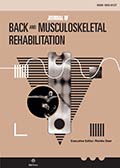Authors: Radwan, Ahmed | Bigney, Kyle A. | Buonomo, Haily N. | Jarmak, Michael W. | Moats, Shannon M. | Ross, Jaimie K. | Tatarevic, Enida | Tomko, Mary Anne
Article Type:
Research Article
Abstract:
PURPOSE: To evaluate the extent of intra-subject difference in hamstring flexibility and its possible relationship to the severity of Low Back Pain (LBP). A secondary purpose was to evaluate the extent of intra-rater reliability using both electrogoniometer and conventional goniometer for measuring hamstring tightness. IMPORTANCE: Potential correlations between muscle impairments and LBP may lead to more effective treatments and prevention strategies. METHODS: Seventy two participants with mechanical LBP were recruited for this study. The sample included; 41 females, 31 males with a mean age of 33.69 ± (11.04) years, height of 170 ± (9) cm, and
…weight of 79.5 ± (1.6) kg. Hamstring length was detected indirectly using the Active Knee Extension method in the 90/90 position from supine. The amount of extension was measured using both electro-goniometer (EG)and a standard goniometer (SG). RESULTS: Right lower extremities of these patients were significantly more flexible than left ones at α = 0.025 (t 72 = 3.14 , p = 0.002 ). Similarly, dominant lower extremities of these patients were significantly more flexible than the non dominant ones at α = 0.025 (t 72 = 2.56 , p = 0.013 ). Additionally, Oswestry scores of the patients were significantly and positively correlated with the amount of hamstring tightness of the right lower extremities (r = 0.244 , p = 0.039 ), left lower extremities (r = 0.225 , p = 0.048 ) and the average of both sides (r = 0.24 , p = 0.039 ). However, the Oswestry scores were negatively, but insignificantly correlated to the absolute difference between right and left extremities at (r = − 0.156 , p = 0.091 ). Finally, the extent of intrasubject reliability in measuring hamstring tightness using EG and SG was found to be high (ICC=0.93). CONCLUSION: There is a possible relation between mild mechanical LBP and hamstrings tightness. It was found that the more the tightness, the higher the severity of LBP that patient experienced. Also, these patients had one of their lower extremities significantly tighter than the other. Such tightness was successfully detected utilizing both EG and SG. These findings and their possible pathomechanical consequences should be considered while constructing effective rehabilitation protocols for patients with mechanical LBP.
Show more
Keywords: Hamstring, tightness, low back pain
DOI: 10.3233/BMR-140490
Citation: Journal of Back and Musculoskeletal Rehabilitation,
vol. 28, no. 1, pp. 61-66, 2015
Price: EUR 27.50





